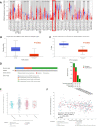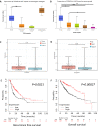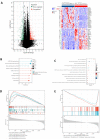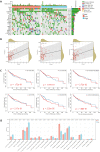Six-Transmembrane Epithelial Antigen of Prostate 4: An Indicator of Prognosis and Tumor Immunity in Hepatocellular Carcinoma
- PMID: 37101765
- PMCID: PMC10124562
- DOI: 10.2147/JHC.S394973
Six-Transmembrane Epithelial Antigen of Prostate 4: An Indicator of Prognosis and Tumor Immunity in Hepatocellular Carcinoma
Abstract
Purpose: The six-transmembrane epithelial antigen of prostate 4 (STEAP4) has been linked to tumor progression via its involvement in inflammatory responses, oxidative stress, and metabolism. However, STEAP4 has rarely been studied in hepatocellular carcinoma (HCC). We explored STEAP4 expression associated with tumor prognosis to understand its role in tumor biology in HCC.
Patients and methods: STEAP4 mRNA and protein expressions were primarily analyzed using bioinformatics tools based on The Cancer Genome Atlas database to understand the expression pattern, molecular mechanism, prognostic impact, and association with immune cell infiltration. We further investigated the association between STEAP4 protein expression and clinicopathological parameters and their predictive value in HCC patients using immunohistochemical staining of tissue microarrays.
Results: The expression of STEAP4 mRNA and protein in HCC tissues was significantly lower than in normal liver tissues. Reduced expression of STEAP4 was linked to advanced HCC stages, poor recurrence-free survival (RFS), and overall survival. Furthermore, reduced STEAP4 expression was a significant predictor of worse RFS in univariate and multivariate analyses in the immunohistochemical cohort. GO, KEGG, and GSEA analyses revealed that STEAP4 is related to numerous biological processes and pathways, including drug metabolism, DNA replication, RNA metabolism, and immune response. In terms of the immune system, the decreased level of STEAP4 was correlated with the immunosuppressive microenvironment.
Conclusion: Our data indicated that reduced STEAP4 expression was significantly associated with tumor aggressiveness and poor prognosis, possibly because of its link to various biological processes and induction of HCC immune evasion. Therefore, STEAP4 expression may serve as a potential prognostic biomarker for cancer progression and immunity, as well as a therapeutic target in HCC.
Keywords: Hepatocellular carcinoma; bioinformatics; immunohistochemistry; prognostic factor.
© 2023 Ju et al.
Conflict of interest statement
The authors report no conflicts of interest in this work.
Figures






Similar articles
-
STEAP4 with copper reductase activity suppresses tumorigenesis by regulating the cell cycle in hepatocellular carcinoma cells.Cell Div. 2024 Dec 24;19(1):35. doi: 10.1186/s13008-024-00140-y. Cell Div. 2024. PMID: 39719623 Free PMC article.
-
Immune responses of six-transmembrane epithelial antigen of the prostate 4 functions as a novel biomarker in gastric cancer.World J Clin Oncol. 2023 Aug 24;14(8):297-310. doi: 10.5306/wjco.v14.i8.297. World J Clin Oncol. 2023. PMID: 37700807 Free PMC article.
-
Potential of six-transmembrane epithelial antigen of the prostate 4 as a prognostic marker for colorectal cancer.World J Gastrointest Oncol. 2022 Sep 15;14(9):1675-1688. doi: 10.4251/wjgo.v14.i9.1675. World J Gastrointest Oncol. 2022. PMID: 36187390 Free PMC article.
-
Upregulation of Stress-Induced Protein Kinase CK1 Delta is associated with a Poor Prognosis for patients with Hepatocellular Carcinoma.Genet Test Mol Biomarkers. 2021 Jul;25(7):504-514. doi: 10.1089/gtmb.2020.0093. Genet Test Mol Biomarkers. 2021. PMID: 34280005
-
The Usefulness of STEAP Proteins in Prostate Cancer Clinical Practice.In: Bott SRJ, Ng KL, editors. Prostate Cancer [Internet]. Brisbane (AU): Exon Publications; 2021 May 27. Chapter 10. In: Bott SRJ, Ng KL, editors. Prostate Cancer [Internet]. Brisbane (AU): Exon Publications; 2021 May 27. Chapter 10. PMID: 34181381 Free Books & Documents. Review.
Cited by
-
Theranostic dye entrapped in an optimized blended-polymer matrix for effective photodynamic inactivation of diseased cells.Naunyn Schmiedebergs Arch Pharmacol. 2025 Jan;398(1):867-880. doi: 10.1007/s00210-024-03321-2. Epub 2024 Jul 29. Naunyn Schmiedebergs Arch Pharmacol. 2025. PMID: 39073418
-
STEAP4 with copper reductase activity suppresses tumorigenesis by regulating the cell cycle in hepatocellular carcinoma cells.Cell Div. 2024 Dec 24;19(1):35. doi: 10.1186/s13008-024-00140-y. Cell Div. 2024. PMID: 39719623 Free PMC article.
-
Inflammatory response in gastrointestinal cancers: Overview of six transmembrane epithelial antigens of the prostate in pathophysiology and clinical implications.World J Clin Oncol. 2024 Jan 24;15(1):9-22. doi: 10.5306/wjco.v15.i1.9. World J Clin Oncol. 2024. PMID: 38292664 Free PMC article. Review.
References
-
- Müller M, Bird TG, Nault JC. The landscape of gene mutations in cirrhosis and hepatocellular carcinoma. J Hepatol. 2020;72:990–1002. - PubMed
LinkOut - more resources
Full Text Sources

